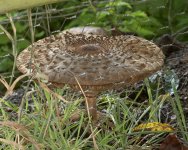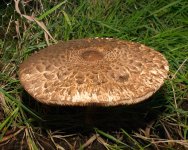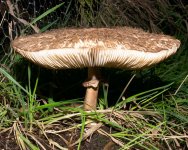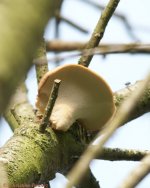-
Welcome to BirdForum, the internet's largest birding community with thousands of members from all over the world. The forums are dedicated to wild birds, birding, binoculars and equipment and all that goes with it.
Please register for an account to take part in the discussions in the forum, post your pictures in the gallery and more.
You are using an out of date browser. It may not display this or other websites correctly.
You should upgrade or use an alternative browser.
You should upgrade or use an alternative browser.
Mushroom ID (1 Viewer)
- Thread starter Saphire
- Start date
More options
Who Replied?Silver
Registered Sane
mothman said:Hi Christine.
It is a Parasol Mushroom(Lepiota procera)
Hmm, sorry, I have to disagree slightly. The cap has those big, shaggy scales and the stem is smooth below the ring, so it is a Shaggy Parasol, Macrolepiota rhacodes.
Alan
(pleased to be back in this forum after a certain well-known national telephone company took two weeks to fix his phone line)
mothman
Well-known member
Yes you are probably right because I only ruled out Lepiota rachodes on size grounds.Silver said:Hmm, sorry, I have to disagree slightly. The cap has those big, shaggy scales and the stem is smooth below the ring, so it is a Shaggy Parasol, Macrolepiota rhacodes.
Alan
(pleased to be back in this forum after a certain well-known national telephone company took two weeks to fix his phone line)
Last edited:
Silver
Registered Sane
Saphire said:I have just measured it, it is 21cm across as well as about the same height, I have read that they are edible but don't know whether I would have the nerve to try one.
Hello Christine, I think you are right to be cautious.
Macrolepiota rhacodes gets three knives and forks, the top edibility rating, in "K&R" (long the best identification guide for European toadstools but now very out of date and, sadly, written in French). I am also sure that there are many who regularly eat fungi who would agree with that rating for M. rhacodes.
However, some people do report gastric upsets and there are also some closely related species that make identification tricky. These two cautions might well be connected.
Roger Phillips's classic 'Mushrooms and other Fungi of Great Britain and Europe' (the version that has been out for many years, not his new book which I haven't bought yet) illustrates both points. He mentions M. rhacodes as sometimes causing gastric upsets, and his photograph of M. rhacodes is now considered to be M. olivieri, a species that was hardly known when he published his book but which may well be quite common.
While spore measurements are needed for certain identification, I remain confident that your photographs are of "good" M. rhacodes. If you want to experiment, I just urge that you try just a little first time.
And this is NOT an encouragement to anyone else who thinks their fungus is the same as Christine's!
Leif regularly posts sound advice on having to be really certain of the identification before eating any wild mushroom, and bear in mind that the field guides include only a small selection of even the commoner fungi (whatever the cover might say!). Personally I consider that none of the true gill fungi is worth eating anyway!
Alan
Last edited:
mothman
Well-known member
You mentioning Roger Phillips is a bit of a coincidence! .Silver said:Hello Christine, I think you are right to be cautious.
Macrolepiota rhacodes gets three knives and forks, the top edibility rating, in "K&R" (long the best identification guide for European toadstools but now very out of date and, sadly, written in French). I am also sure that there are many who regularly eat fungi who would agree with that rating for M. rhacodes.
However, some people do report gastric upsets and there are also some closely related species that make identification tricky. These two cautions might well be connected.
Roger Phillips's classic 'Mushrooms and other Fungi of Great Britain and Europe' (the version that has been out for many years, not his new book which I haven't bought yet) illustrates both points. He mentions M. rhacodes as sometimes causing gastric upsets, and his photograph of M. rhacodes is now considered to be M. olivieri, a species that was hardly known when he published his book but which may well be quite common.
While spore measurements are needed for certain identification, I remain confident that your photographs are of "good" M. rhacodes. If you want to experiment, I just urge that you try just a little first time.
And this is NOT an encouragement to anyone else who thinks their fungus is the same as Christine's!
Leif regularly posts sound advice on having to be really certain of the identification before eating any wild mushroom, and bear in mind that the field guides include only a small selection of even the commoner fungi (whatever the cover might say!). Personally I consider that none of the true gill fungi is worth eating anyway!
Alan
On Friday, I was helping at my little sons school at a Fungus Foray (his school comprises of 60 pupils and is slap bang in the middle of the Savernake forest)
I noticed the Mycologist that the Headmistress had invited, was refering to Roger Phillip's book.
"Oh I have that book, it is good isn't it"I said.
"When did you get it" he asked
"Oh about 6 years ago"I said.
"Well Ive written a new one since then" He said.
I was bloody embarassed I can tell you!
He really does look the part too!!
Attachments
Last edited:
mothman
Well-known member
It is interesting to note that you use Macrolepiota where I use Lepiota, any ideas where the differing names originate from for this species?Silver said:Hello Christine, I think you are right to be cautious.
Macrolepiota rhacodes gets three knives and forks, the top edibility rating, in "K&R" (long the best identification guide for European toadstools but now very out of date and, sadly, written in French). I am also sure that there are many who regularly eat fungi who would agree with that rating for M. rhacodes.
However, some people do report gastric upsets and there are also some closely related species that make identification tricky. These two cautions might well be connected.
Roger Phillips's classic 'Mushrooms and other Fungi of Great Britain and Europe' (the version that has been out for many years, not his new book which I haven't bought yet) illustrates both points. He mentions M. rhacodes as sometimes causing gastric upsets, and his photograph of M. rhacodes is now considered to be M. olivieri, a species that was hardly known when he published his book but which may well be quite common.
While spore measurements are needed for certain identification, I remain confident that your photographs are of "good" M. rhacodes. If you want to experiment, I just urge that you try just a little first time.
And this is NOT an encouragement to anyone else who thinks their fungus is the same as Christine's!
Leif regularly posts sound advice on having to be really certain of the identification before eating any wild mushroom, and bear in mind that the field guides include only a small selection of even the commoner fungi (whatever the cover might say!). Personally I consider that none of the true gill fungi is worth eating anyway!
Alan
Roger Phillips(or Roj as i now call him
Silver
Registered Sane
mothman said:It is interesting to note that you use Macrolepiota where I use Lepiota, any ideas where the differing names originate from for this species?
Roger Phillips(or Roj as i now call him) only gives passing mention of the former in my copy preferring Lepiota.
Ye gods! Roger looks a lot older than when I last saw him.
Happening to us all I suppose.
And perhaps it was Roger who influenced our adopting Macrolepiota in Britain. He organised the translation and publishing, in 1983, of an excellent German book by Meinhard Moser and, in that book, the large and heterogeneous genus Lepiota was split up into several component parts. Actually, Moser was following a massively important earlier book by Singer, but Singer's weighty academic tome wasn't top of the reading list for most field mycologists (though arguably it should have been).
Anyhow, Moser's keys were quickly adopted as a sort of standard in Britain and the treatment of the old Lepiota made immediate sense, ecologically as well as morphologically. So in the last two decades, both here and on the continent, Macrolepiota has become established as the genus for M. rhacodes, M. procera and their allies. True Lepiota species are generally rather dainty fungi with important differences in their spore characters and often with a prediliction for growing on rich woodland soils under Dog's Mercury. It isn't wrong to keep rhacodes etc. in Lepiota, but it's rather like saying Marsh Marigolds are just buttercups. The new British checklist uses Macrolepiota.
If there is a dispute, it is whether Macrolepiota is really separate from the tropical genus (alien in Britain), Chlorophyllum. If anyone happens to have a large "parasol mushroom" with green gills and green spores coming up in their hothouse,
a) don't eat it; it is poisonous,
b) let me know so I can come and photograph it!
Alan
If anyone is interested, I do not recommend eating M. rhacodes, as IMO it is slimy and disgusting. The Field Parasol, M. procera is much better, and easily identified by the experienced, but easily misidentified by the inexperienced. There are some very nasty species in the Lepiota genus, and it is all too easy to make a mistake.
Like Alan, I tend not to eat gilled fungi, apart from cultivated ones, though the Saffron Milkcap is one exception. My finds over the last week include Yellow Stainers (causing gastric upsets) and Death Caps (causing death, oddly enough).
Leif
Like Alan, I tend not to eat gilled fungi, apart from cultivated ones, though the Saffron Milkcap is one exception. My finds over the last week include Yellow Stainers (causing gastric upsets) and Death Caps (causing death, oddly enough).
Leif
Silver
Registered Sane
Leif said:If anyone is interested, I do not recommend eating M. rhacodes, as IMO it is slimy and disgusting.
Leif
LOL! Exactly my argument against eating cultivated mushrooms.
Not to mention the disgusting objects, presumably shiitake, that I have to remove from Chinese take-aways.
Alan
Silver
Registered Sane
Perhaps I can hijack this thread slightly and ask how the fungus season is going in East Anglia just now? I need to make a trip down to continue my recording at Wicken Fen, Cambridgeshire, but I am quite good at choosing those times when the fungus season has gone into a decline.
And to make it relevant to the thread, no Macrolepiota or true Lepiota species recorded for the reserve yet, but I do have some potential places in mind. (Cystolepiota we do have now.)
If anyone happens to have mycological records from Wicken Fen (good birding place of course), I'd be happy to have them sent to me. Website at http://www-biol.paisley.ac.uk/research/Asilverside/Wickenfungi.html, though it needs to be revamped and a lot of recent records added.
Who will be the first to record a puffball, or a bolete (other than Paxillus), or an Amanita, or perhaps even somehow add to the impressive array of, um, one milkcap?
Alan
And to make it relevant to the thread, no Macrolepiota or true Lepiota species recorded for the reserve yet, but I do have some potential places in mind. (Cystolepiota we do have now.)
If anyone happens to have mycological records from Wicken Fen (good birding place of course), I'd be happy to have them sent to me. Website at http://www-biol.paisley.ac.uk/research/Asilverside/Wickenfungi.html, though it needs to be revamped and a lot of recent records added.
Who will be the first to record a puffball, or a bolete (other than Paxillus), or an Amanita, or perhaps even somehow add to the impressive array of, um, one milkcap?
Alan
Silver said:Perhaps I can hijack this thread slightly and ask how the fungus season is going in East Anglia just now? I need to make a trip down to continue my recording at Wicken Fen, Cambridgeshire, but I am quite good at choosing those times when the fungus season has gone into a decline.
Hello Alan: I am in Luton, which is 45 minutes drive from Cambridge. Maybe my comments can be of interest. Here the season is starting to get up steam, with local woods producing nice specimens of Amanita, Boletus etc. Some of my recent finds include Geastrum sessile and Amanita inaurata in nice condition. Burnham Beeches, near Slough, and the New Forest are rather productive. (I was in the New Forest today.) The larger Cortinarius are as yet largely absent. It is thus far a rather good year, given the previous 3 dreadful seasons.
I hope to visit Hatfield Forest tomorrow, and hopefully it too will be productive.
The first frosts tend to put paid to many species, leaving the rubbery ones to dominate. As you probably know frosts here can appear any time from mid October.
Leif
Silver
Registered Sane
Leif said:Hello Alan: I am in Luton, which is 45 minutes drive from Cambridge. Maybe my comments can be of interest. Here the season is starting to get up steam, with local woods producing nice specimens of Amanita, Boletus etc. Some of my recent finds include Geastrum sessile and Amanita inaurata in nice condition. Burnham Beeches, near Slough, and the New Forest are rather productive. (I was in the New Forest today.) The larger Cortinarius are as yet largely absent. It is thus far a rather good year, given the previous 3 dreadful seasons.
I hope to visit Hatfield Forest tomorrow, and hopefully it too will be productive.
The first frosts tend to put paid to many species, leaving the rubbery ones to dominate. As you probably know frosts here can appear any time from mid October.
Leif
Leif, thank you. This is really helpful.
I hope Hatfield Forest was good. I knew the forest well in my youth (my uncle was warden of the nature reserve by the lake) but oddly I have never been there in the main fungus season.
Alan
Silver said:Leif, thank you. This is really helpful.
I hope Hatfield Forest was good. I knew the forest well in my youth (my uncle was warden of the nature reserve by the lake) but oddly I have never been there in the main fungus season.
Alan
Hello Alan: Sadly Hatfield Forest was rather poor, although there were plenty of field mushrooms, quite a few clumps of Psathyrella multipedata, and quite a few Parrot Wax Caps. But the woods proper were fairly barren. My suspicion is that it has been fairly wet and that well drained sites are doing the best. Hatfield Forest looked to be a clay soil, or at least not well drained.
Leif
Similar threads
- Replies
- 2
- Views
- 617
Users who are viewing this thread
Total: 2 (members: 0, guests: 2)








